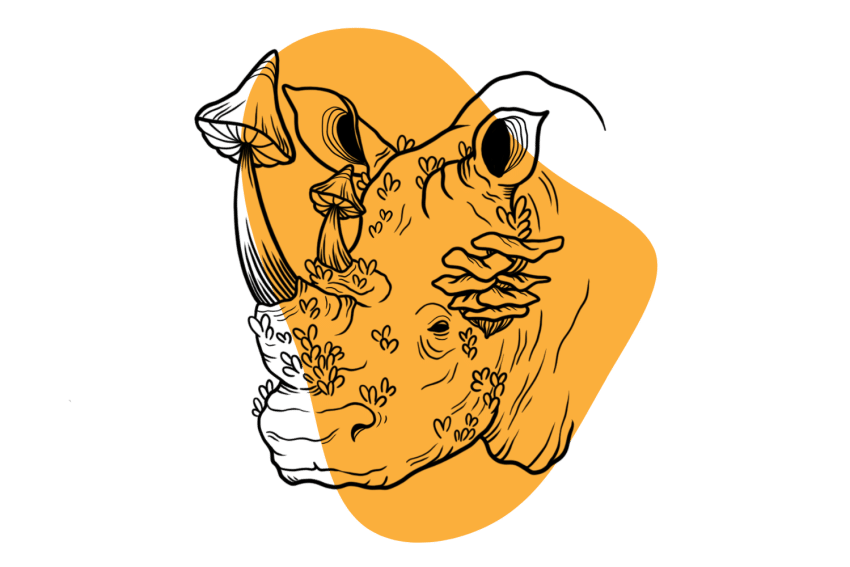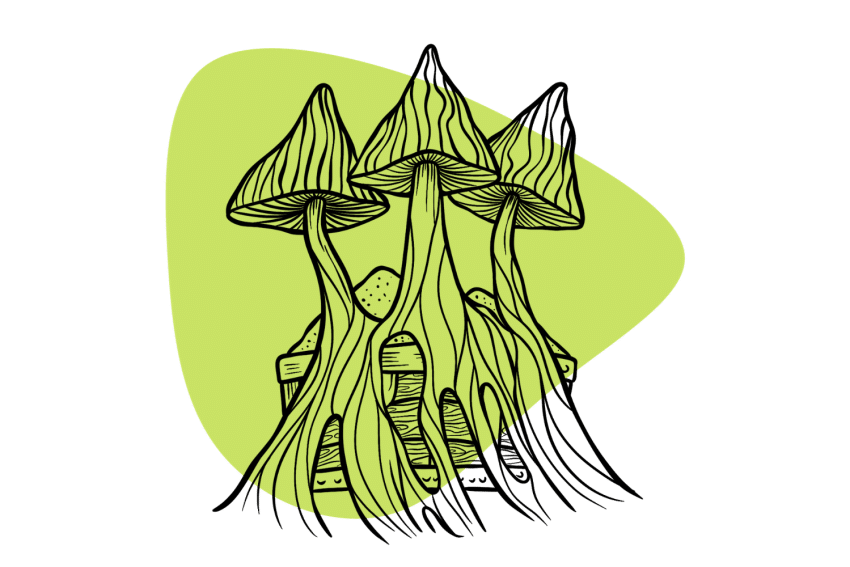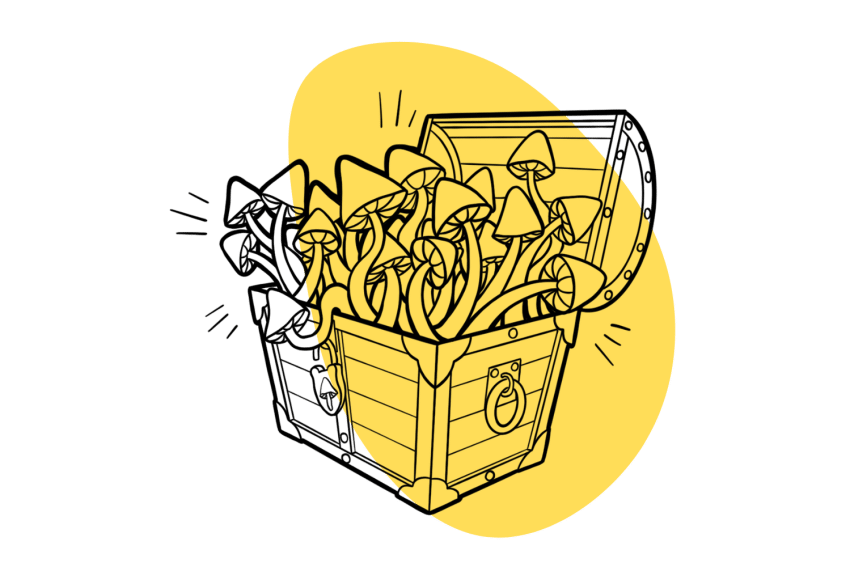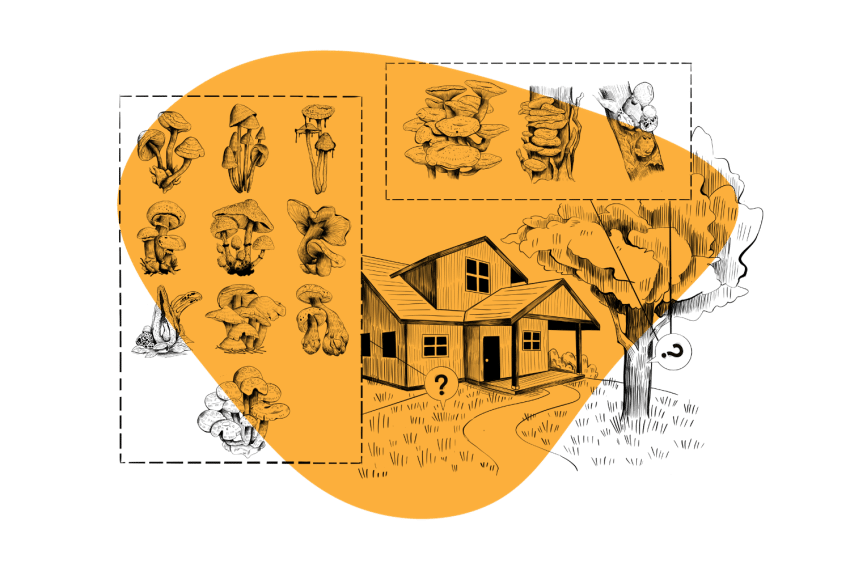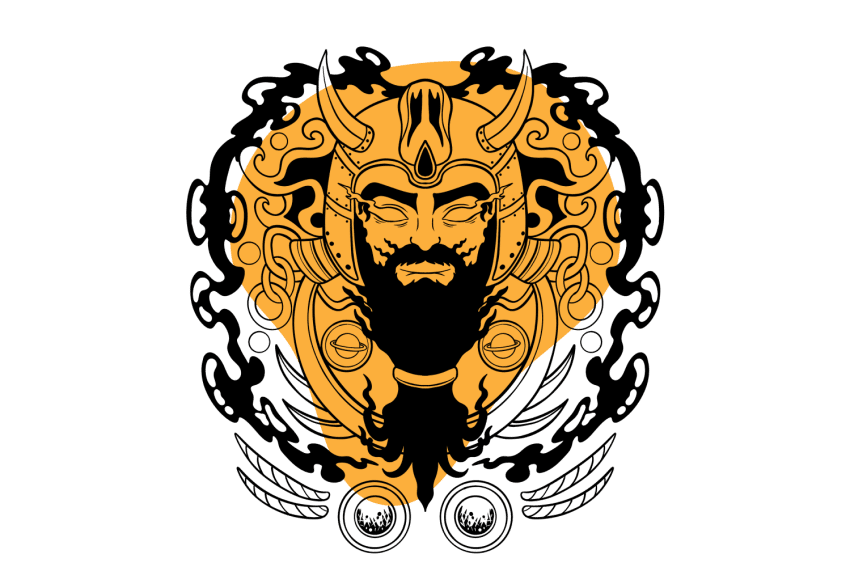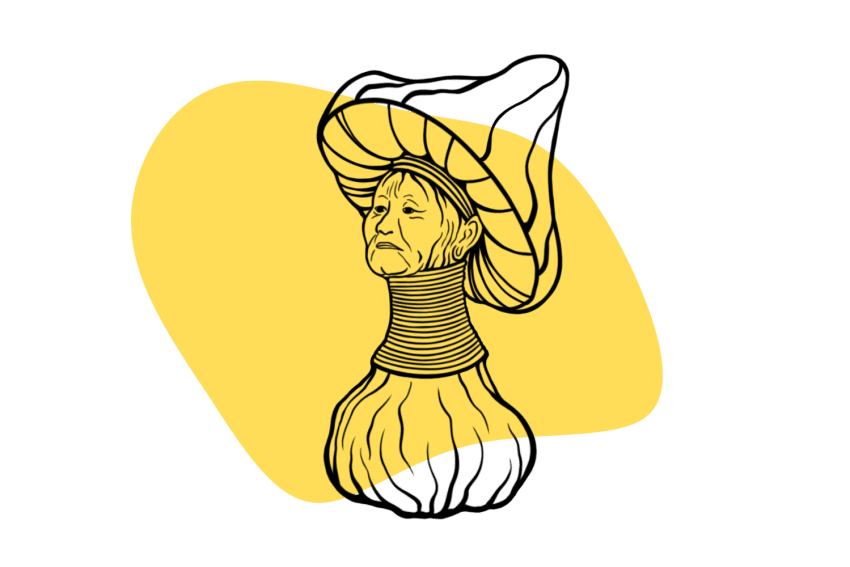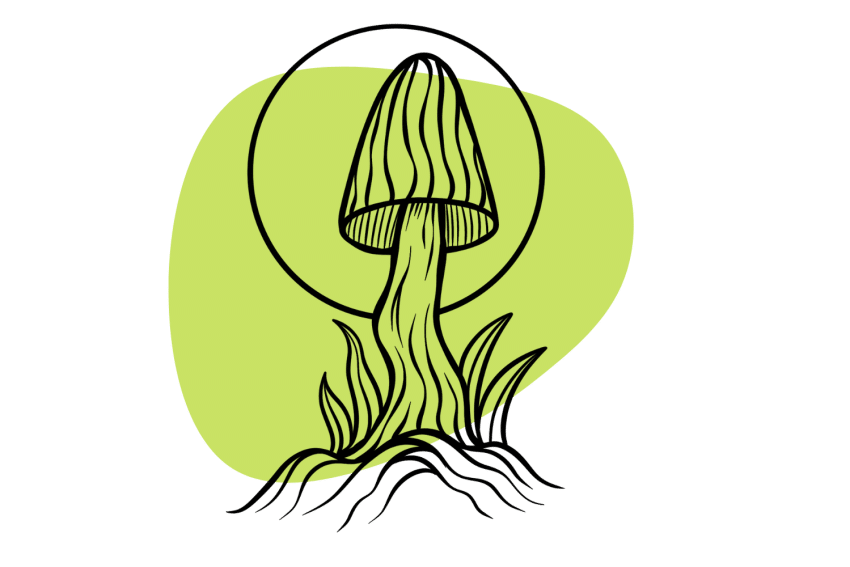Who Discovered Magic Mushrooms?
Magic mushrooms have been used for millennia. The first people to discover them likely lived in a cave and hunted and gathered food…
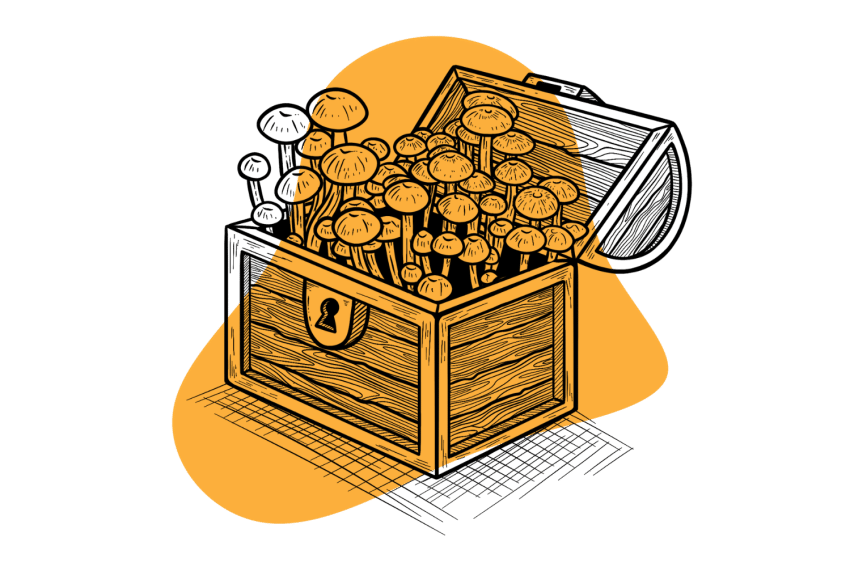
The discovery and use of magic mushrooms (mushrooms containing psilocybin) cannot be attributed to a single individual. These mushrooms have a long history of use on all four corners of the globe — many cultures have employed them for religious, spiritual, and shamanic purposes for thousands of years.
Nobody knows for sure who or which culture first decided to munch on psilocybin-containing mushrooms — one theory even suggests humanity evolved as a direct byproduct of earlier primates eating them as a source of food (called the stoned ape theory).
While it’s unclear who truly discovered these mushrooms, we do know who first publicized them in the West — an anthropologist named Richard Evan Shultes.
In this article, we’ll look at:
- The ancient history of magic mushroom use
- The first recorded mushroom trip
- The first Westerner to discover magic mushrooms
- Richard Evan Schultes — The first Westerner to discover psychedelic mushrooms
- Robert Gordan Wasson — The person who introduced the West to magic mushrooms
- Maria Sabina — The mother of mushrooms
- Albert Hofmann — the person who discovered psilocybin
The Ancient History of Magic Mushroom Use
Psychedelic plants and fungi have been used for thousands of years to reach higher states of consciousness, connect with the gods, form deeper connections to nature, and heal the mind, body, and soul.
Some scientists believe that shroom consumption has been a practice dating back to the development of our cognitive capacities when we became “evolutionary distinct.” This assumption is based on observations of other species, such as dolphins, reindeer, bighorn sheep, and jaguars, that actively seek out and ingest psychedelic substances.
Related: Wavy Wildlife — Which Animals Take Psychedelics, & Why?
Mushrooms in the genus Psilocybe are not only common, but they’re widespread and found on every continent inhabited by humans. It’s unlikely that early humans managed to avoid shrooms; they probably incorporated magic mushrooms into their diets.
Renowned ethnobotanist and psychonaut Terence McKenna went a step further, suggesting that the consumption of these mushrooms may have catalyzed human evolution.
McKenna’s “Stoned Ape” theory proposed that psilocybin ingestion induced a heightened state of interconnectivity within the neural networks of early humans. This potentially led to an expansion in brain size, fostering the development of innovative technologies and serving as a catalyst for the emergence of concepts like religion and language.
Prehistoric Humans & Magic Mushroom Use
It’s believed psilocybin mushrooms have been used spiritually and medicinally for over 12,000 years. Although evidence of mushroom use this far back is lacking, a series of stone paintings discovered in the Kimberley region of Australia can be interpreted as a symbol of psilocybin use.
The “Bradshaw rock art” is a series of paintings spread across 100,000 sites in an area of 50,000 square kilometers (around 12.4 million acres) that are believed to be at least 12,000 years old [1]. Several of these ancient artworks feature “the mushroom head” — a symbol that many scientists interpret as a symbol of magic mushroom use [2].
The symbols found in the Bradshaw Rock Art of Kimberley are open to interpretation. Although several researchers believe that the depictions of mushrooms could detail the ancient peoples’ consumption of psychedelic mushrooms, we can’t be 100% sure. However, there’s more substantial evidence supporting the use of psilocybin mushrooms in later cultures from 1500 BCE onwards.
Ancient Civilizations & Magic Mushroom Use
Magic mushrooms have a long history of use among indigenous cultures, especially in Mesoamerica (Mexico and Central America), where the people used species like Psilocybe mexicana and Psilocybe cubensis for their psychoactive effects.
Archaeological evidence suggests that these mushrooms were a part of rituals and spiritual ceremonies dating back to ancient civilizations such as the Mayans and Aztecs. These cultures regarded psilocybin mushrooms as sacred and integral to their religious practices.
1. The Mayan Civilization
The Mayans, who thrived in (present-day) Mexico and Central America from approximately 1500 BCE to 1500 CE, left behind inscriptions and artwork that provide an in-depth insight into their use of magic mushrooms. They believed that consuming these mushrooms allowed them to communicate with the divine and access spiritual realms.
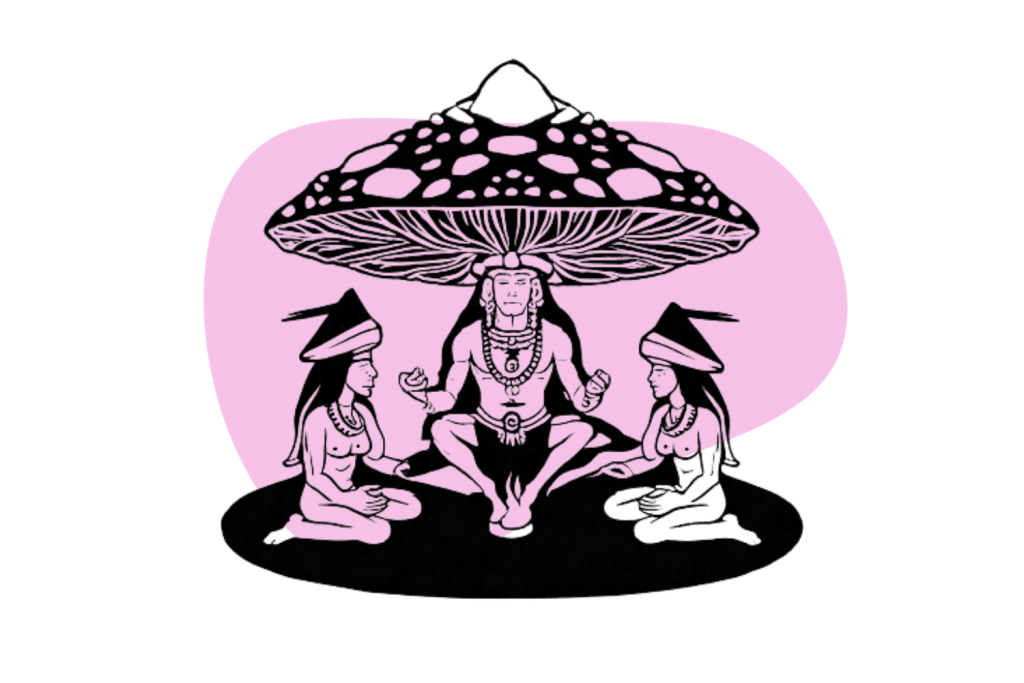
Some of the Mayans’ most famous mushroom relics are known as the “mushroom stones.” These phallic-shaped sculptures feature a variety of different faces, all crowned with mushroom-shaped caps. They are believed to have played a role in religious ceremonies where shrooms were consumed [3].
The Maya were avid users of psychedelic plants and fungi. They had an advanced knowledge of the natural world around them and regularly incorporated psychoactive substances into religious ceremonies, medical practices, and general daily life.
Plants and fungi such as peyote (Lophophora williamsii), magic mushrooms (Psilocybe spp.), the seeds of ololiuqui (Turbina corymbosa), Jimson weed (Datura stramonium), wild tobacco (Nicotiana rustica), and Salvia divinorum have been observed as illustrations on Mayan stone carvings and other artifacts [4].
2. The Aztec Civilization
The Aztecs — a later Mesoamerican civilization that existed from the 13th to the 16th century — incorporated magic mushrooms into their religious ceremonies. In Aztec culture, the mushrooms were associated with the god Xochipilli — “the Prince of Flowers and patron of art, games, beauty, and love.”
Psilocybin mushrooms — likely Psilocybe mexicana and perhaps Psilocybe cubensis — were known as “teonanácatl,” meaning “Flesh of the Gods.” The Aztecs also used a variety of other psychoactive plants to help contact the gods and achieve a trance-like state of consciousness.
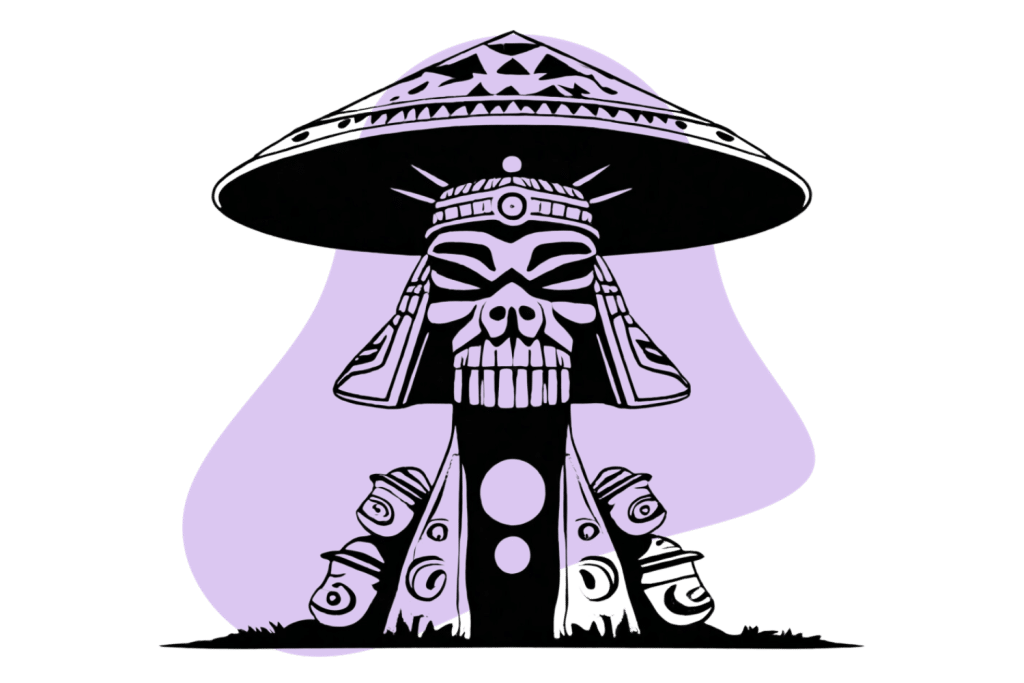
The Florentine Codex — a historic ethnographic work composed of 12 books — contains several references to the use of magic mushrooms and other entheogens among the Aztecs [5]. In the 11th book, R. Gordon Wasson, Richard Evan Schultes, and Albert Hofmann dissect a famous statue of the Aztec god “Xochipilli.”
The three researchers compared the intricate carvings on the statue to native organisms in the region and found that they symbolize several psychoactive plants and fungi that the Aztecs likely consumed in religious rituals and ceremonies.
According to them, the statue portrays six different sacred herbs — Psilocybe aztecorum, the flower of Heimia salicifolia, the bud of Heimia salicifolia, the tendril of morning glory (Ipomoea spp.), the flower of Rivea corymbosa, and the flower of Nicotiana tabacum.
The First Reported Psilocybin Trip
In 1799, a poor family went picking mushrooms in Saint James’s Green Park in London, England. They prepared a meal to eat for breakfast from the mushrooms they had collected. Among the shrooms gathered were several Psilocybe semilanceata (Liberty Caps). However, at the time, it was an unknown species.
After eating their breakfast, the father and children began to feel strange. They had dilated pupils and vertigo and were laughing uncontrollably. The father also reported that, at one point, he believed he was poisoned and was going to die. We now know that what the family experienced was a psilocybin trip. However, this wasn’t common knowledge at the time, and the unidentified species was labeled as highly poisonous.
Later that year, a chemist named Augustus Everard Brande published an article called “On a Poisonous Species of Agaric” in the London Medical & Physical Journal [6]. The article detailed the family’s experience and wrongly identified the species as Agaricus glutinosus.
The family’s experience was later outlined in a book called “Coloured Figures of English Fungi or Mushroom” by James Sowerby (1803). Clear illustrations of Psilocybe semilanceata can be seen above a brief mention that reads, “Liberty Caps nearly proved fatal to a poor family in Piccadilly, London, who was so indiscreet as to stew a quantity (found in St. James’s Green Park) for breakfast.”
Although this was the first reported account of “magic mushrooms,” the species was ruled out as poisonous, and there was no further exploration into their scientific and medical value. It wasn’t until much later that mushrooms in the Psilocybe genus would be rediscovered and recognized for what they are.
Who Was the First Westerner to Discover Magic Mushrooms?
Robert Gordan Wasson is often credited as “the first Westerner to discover magic mushrooms.” However, this isn’t entirely true.
Although R. Gordan Wasson did introduce psilocybin-containing mushrooms to the public eye of the West, other researchers of the time were also studying hallucinogenic fungi. Wasson didn’t stumble across magic mushrooms by chance; he was “tipped off” by another legend in psychedelics — Richard Evan Shultes.
Schultes was an ethnobotanist of the time who presented Robert Gordan Wasson with evidence of a “mushroom cult” in Mexico. He sent Wasson a letter that explained that he’d witnessed a shamanic ritual where psychedelic fungi were used to induce a trance-like state. He slipped a sample of the mysterious fungi in the letter — a species now known as Psilocybe mexicana.
This letter was a major catalyst in the psychedelic revolution of the ’60s. It led to the West’s introduction to psychedelic shrooms and the discovery of psilocybin — the active component in magic mushrooms.
Including Schultes and Wasson, there are four key figures responsible for the “discovery” of magic mushrooms in modern times. Let me introduce you to them.
1. Richard Evan Schultes — The Westerner Who Discovered Psychedelic Shrooms
Richard Evan Schultes (1905–2001) is known as the father of “ethnobotany” — the study of the traditional knowledge of people and cultures concerning plants and their medical, religious, and spiritual uses.
Schultes was one of the most famous and well-regarded explorers of the Amazon rainforest from the 20th century. He was the first Westerner to study ayahuasca and its uses in the Amazon, the first to discover what the Aztecs called “teonanácatl” (Flesh of the Gods), and one of the key figures in the discovery of psilocybin.
Richard Evan Schultes Hears About “The Flesh of the Gods”
During Schulte’s early studies of the peyote cactus, he stumbled across references to a sacred substance (teonanácatl) used by the Aztecs to “contact the gods.” He studied the “Codex Vindobonensis Mexicanus,” which illustrates the seven Aztec gods holding mushrooms while beating a drum made from a human skull — Schultes believed that these mushrooms were, in fact, teonanácatl.
Although a leading botanist of the time — William Safford — discouraged the existence of a “sacred hallucinogenic mushroom,” Schultes was certain of its existence. Safford claimed that teonanácatl was actually peyote, and the natives were trying to mislead the Catholic Church by depicting mushrooms so they could consume the cactus without problems.
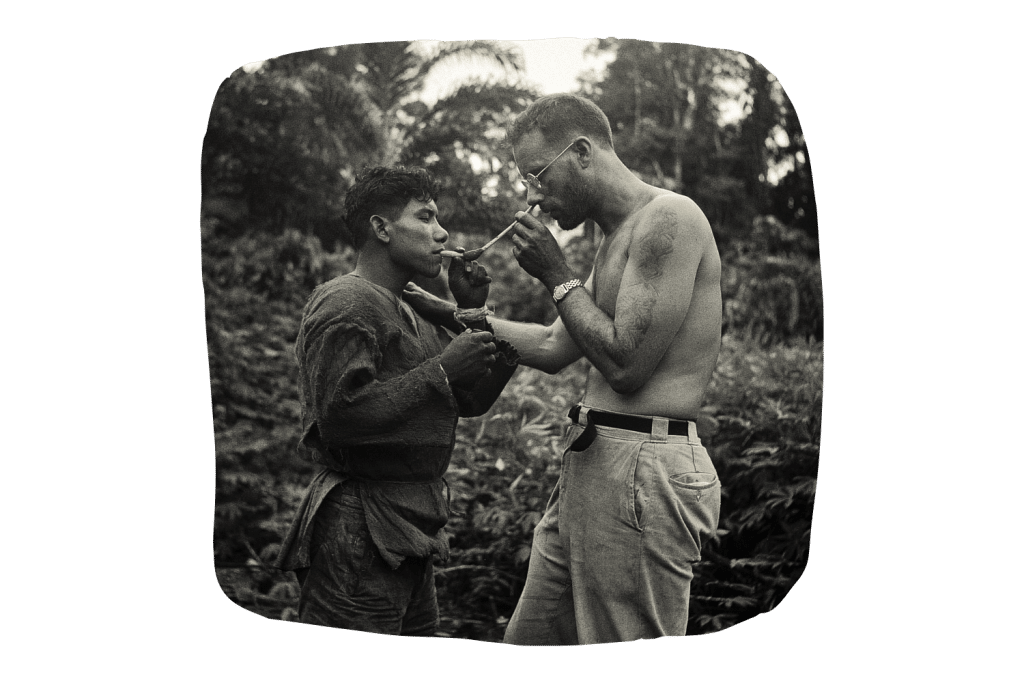
Schultes was skeptical of Safford’s theory because he didn’t understand how Aztec cultures residing in the wet regions of southern Mexico could use psychedelic cactus growing in very specific regions of the northern deserts.
During his research, Richard Evan Schultes came across a letter from Mr. Blas Pablo Reko — an Australian living in Mexico. The letter — addressed to Harvard Herbarium Director J.N. Rose — stated that teonanácatl was a psychedelic mushroom and the Mazatec tribes of the Oaxaca region still used the mushroom in their ceremonies.
This was all the information Schultes needed, and in 1938, he traveled to Oaxaca to meet Blas Pablo Reko and investigate the claims.
Schultes Goes in Search of the Sacred Fungi
When he reached Mexico City, Schultes traveled with Blas Pablo Reko by train to the Teotitlán region. They quickly found evidence of mushroom use but struggled to find samples of the mysterious fungus due to their sacred status. The two decided to venture further into the mountains on foot in search of teonanácatl. After several weeks of hiking, they reached the remote town of Huautla de Jiménez — the capital of Mazatec country.
While laying out plant samples he had collected during his travels, a Mazatec man approached Schultes and handed him a dozen small mushrooms. The man called them niños santos, “the Sacred Children.”
Schultes identified the mushrooms as a species of Panaeolus, but in reality, they were a species in the Psilocybe genus. Although he had no context for the mushrooms he had received, he had discovered the sacred fungi that had been used in the region for millennia — the mushrooms that the Aztecs called “Flesh of the Gods.”
He still had several unanswered questions about the sacred mushrooms, and the “mushroom ceremonies” he came to explore still eluded him. However, he found out that these psychedelic mushrooms grew in the region between June and September.
Richard Evan Schultes returned to the Oaxaca region one year later to continue his research on teonanácatl.
The Beginning of a New Era
Richard Evan Schultes returned to the Oaxaca region one year after his first expedition. Unfortunately, the late onset of the rainy season meant he could not collect any fresh specimens of the teonanácatl mushrooms. However, he did manage to obtain five dried mushrooms in exchange for a few quinine pills.
He consumed these mushrooms and described the effects he experienced in his paper titled “The Identification of Teonanácatl, A Narcotic Basidiomycete of the Aztecs” [7].
Here’s what he wrote:
“Shortly after ingestion of the mushrooms, the subject experiences a general feeling of levity and well-being. This exhilaration is followed within an hour by hilarity, incoherent talking, uncontrolled emotional outbursts, and, in the later stages of intoxication by fantastic visions in brilliant colors, similar to the visions so often reported for the narcotic peyote.”
It was Richard Evan Schultes’ encounters with these sacred mushrooms that marked the beginning of a new era. Schulte’s paper on teonanácatl set the wheels in motion for the train that was the psychedelic revolution — this is where Robert Gordan Wasson comes in…
2. Robert Gordan Wasson: The Man Who Brought Magical Shrooms to the West
Robert Gordan Wasson is known by many as the godfather of the psychedelic revolution. He’s the man who introduced the Western world to magic mushrooms — without him, who knows how long it would’ve taken for psilocybin to reach the West.
Robert Gordan Wasson’s Introduction to Mushrooms
Wasson’s introduction to mushrooms came from his wife, Valentina. Before her influence, Wasson believed all wild mushrooms were poisonous or inedible.
On the couple’s honeymoon in the Catskills mountains, Valentina found a cluster of mushrooms she recognized from her youth in Russia. That evening, she added the mushrooms to everything she cooked, but her husband refused to eat — convinced that the mushrooms would make him a widower by morning.

Like many Americans at the time, Robert Gordan Wasson was raised to believe that wild mushrooms were dangerous and should not be touched or picked, let alone eaten. Valentina, on the other hand, grew up in Russia, where her family encouraged her to forage for wild mushrooms to bring to the table.
It was the couple’s conflicting views that drove them to study and research mushrooms around the world — perhaps they could discover why their viewpoints were so opposite.
Wasson Begins His Research Into Magic Mushrooms
Robert Gordan Wason and his wife Valentina had been embarking on mushroom-hunting adventures for several years before they stumbled across psilocybin-containing mushrooms. They had traveled across Friesland, Lapland, Provence, and Basque Country in search of mushrooms and their cultural significance.
The couple had gathered a substantial amount of information on mushrooms over the years — enough to publish a book. While preparing and organizing the material for publishing, Wasson realized how many references he had to mushrooms in religion. This made him question whether ancient cultures worshiped mushrooms — this would explain their prevalence in religious artifacts and texts.
Robert and Valentina Wasson decided to continue their mushroom-hunting adventures with a different purpose — to explore the religious significance of mushrooms.
They searched for specific mushrooms that cultures across the globe would consume — from India to the Americas and Europe to China. They discovered references to psychedelic mushrooms in the form of text and stone carvings from Greek and Guatemalan cultures. However, the turning point of their research came in the form of a letter.
Richard Evan Schultes caught wind of the Wasson’s ongoing study, so he presented them with evidence of a “mushroom cult” in the Oaxaca region of Mexico. Schultes sent Robert Gordan Wasson a letter detailing his experiences in Huautla de Jiménez — he even placed a sample of the sacred mushroom Wasson was searching for.
Robert Gordan Wasson: “Seeking the Magic Mushroom”
After receiving the letter from Richard Evan Schultes, Wasson went in search of the mushroom cult in Huautla de Jiménez. Upon arrival, he met a woman called Maria Sabina — a curandera (healer) who used psychedelic mushrooms in her “mushroom ceremonies.”
Robert and Valentina spent most of their time in Huautla de Jiménez from 1953 to 1954, collecting samples of psychedelic mushrooms such as Psilocybe mexicana and P. cubensis, as well as partaking in several mushroom ceremonies with Maria Sabina.
In 1957, Robert Gordan Wasson published a 15-page article in LIFE Magazine that detailed his experience in Huautla de Jiménez with Maria Sabina and her “Sacred Children” (psychedelic shrooms). The article described the cultural and spiritual use of psychedelic mushrooms by the Mazatec people, as well as what he experienced during his trips in the mushroom ceremonies.
He named the article “Seeking the Magic Mushroom” — this is where the term “magic mushroom” came from. We still use it today when referring to any species of psilocybin-producing fungi.
This article went viral, and it inspired thousands of people to search for magic mushrooms in Oaxaca. Everyone from your typical 60s hippy to celebrities such as John Lennon, Keith Richards, and Mick Jagger began traveling to the small town of Huautla de Jiménez to partake in one of Maria’s magic mushroom ceremonies.
The long-kept secret was now out. “Magic mushrooms” had been introduced to the Western world…
3. Maria Sabina: The Mother of Mushrooms
Maria Sabina (1894–1985), “the mother of mushrooms,” was the curandera (medicine woman) who introduced Robert Gordan Wasson to her niños santos (Sacred Children) — magic mushrooms.
She would collect several different types of psilocybin mushrooms from the mountains that surrounded her village. Psilocybe caerulescens, Psilocybe mexicana, and Psilocybe cubensis were commonly used in her mushroom ceremonies for physical and spiritual healing.

Maria Sabina had a vast knowledge of the plants and fungi that inhabited the landscape around Huautla de Jiménez. She was a humble, kind-natured woman who didn’t hesitate to share her knowledge and magic mushrooms with Robert Gordan Wasson.
Unfortunately, Maria Sabina’s kind and sharing nature would eventually lead to her demise. She was partly responsible for the introduction of magic mushrooms to the West, and Wasson’s stories of her and her mushroom ceremonies inspired hundreds of thousands of people to try psychedelics.
Maria Sabina’s Unfortunate Fame
Robert Gordan Wasson’s article in LIFE Magazine encouraged thousands of Westerners to travel to Maria’s small town. The popularity of Maria Sabina and her magic mushrooms started a snowball effect. People would return to the West, telling stories of her mushroom ceremonies, causing more people to travel to the town.
“It’s true that Wasson and his friends were the first foreigners who came to our town in search of the Holy Children (the mushrooms) and that they didn’t take them because they suffered from any illness. Their reason was that they came to find God.” — Maria Sabina
The influx of foreigners to Huautla de Jiménez caused Maria a whole world of problems.
The police in Mexico began to accuse Maria Sabina of drug dealing, and the Westerners in Huautla de Jiménez started to cause trouble while under the influence of psilocybin, disrespecting the locals, land, and Mazatec culture.
No matter how hard she tried, Maria couldn’t stop the continuous flow of foreigners coming to the town.
She famously said, “From the moment the foreigners arrived to search for God, the saint children lost their purity. They lost their force; the foreigners spoiled them. From now on they won’t be any good. There’s no remedy for it.”
Eventually, the close-knit community that Maria Sabina had been a part of her whole life rejected her. They were sick of the disrespectful Westerners coming to the town and wreaking havoc.
The locals burned Maria’s house down and banished her from Huautla de Jiménez. Maria Sabina lost her friends, loved ones, and her home.
Despite her deep misfortune, Maria battled on, remained humble, and kept her faith. She traveled across Mexico, sharing her wisdom with people from around the globe. She preserved and shared the ancient practices of the Mazatec culture with the world. Her wisdom spread worldwide, and her words live on, even after death.
4. Albert Hofmann: The Person To Discover & Synthesize Psilocybin
Albert Hofmann is the Swiss scientist who’s most famous for being the first person to synthesize LSD (lysergic acid diethylamide). However, he also played a part in the discovery of psilocybin and psilocin — the active psychedelic compounds that make magic mushrooms “magic.”
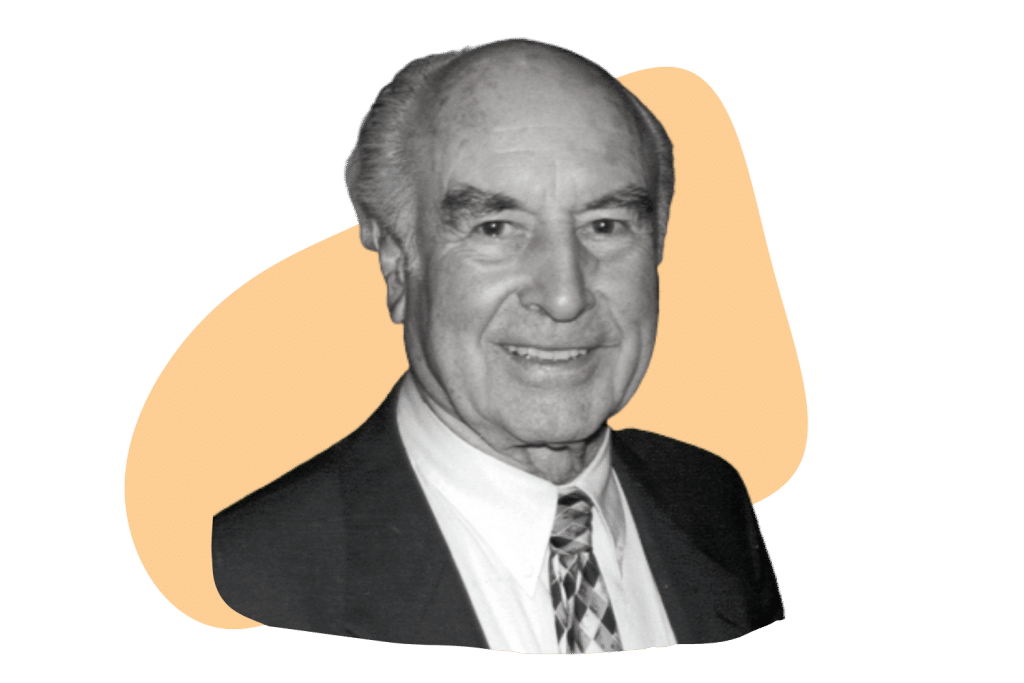
In 1958, Albert Hofmann isolated and identified psilocybin and its metabolite psilocin as the compound(s) responsible for the species’ psychedelic effects — from a selection of Psilocybe mexicana samples that Robert Gordan Wasson sent him. Later, in 1963, Albert Hofmann and fellow Swiss chemist Franz Troxler reported the synthesis of psilocybin in a patent [8].
Although Albert Hofmann seemingly played a small role in the discovery of magic mushrooms and their introduction to the West, his discovery of psilocybin was extremely important. Hofmann’s discovery paved the way for research into the effects of psilocybin and the potential benefits of magic mushrooms.
References
- Finch, D., Gleadow, A., Hergt, J., Levchenko, V. A., Heaney, P., Veth, P., … & Green, H. (2020). 12,000-Year-old Aboriginal rock art from the Kimberley region, Western Australia. Science Advances, 6(6), eaay3922.
- Pettigrew, J. (2011). Iconography in Bradshaw rock art: breaking the circularity. Clinical and Experimental Optometry, 94(5), 403-417.
- Lowy, B. (1971). New records of mushroom stones from Guatemala. Mycologia, 63(5), 983-993.
- Carod-Artal, F. J. (2015). Hallucinogenic drugs in pre-Columbian Mesoamerican cultures. Neurología (English Edition), 30(1), 42-49.
- Anderson, A. J., & Dibble, C. E. (1982). Florentine Codex, introductions and indices. Santa Fe, NM: The School of American Research and the University of Utah.
- Brande E, London Medical and Physical Journal, 1799; Xl: 41–44
- Schultes, R. E. (1940). Teonanácatl: The narcotic mushroom of the Aztecs. American Anthropologist, 42(3), 429-443.
- Hofmann, A., Heim, R., Brack, A., & Kobel, H. A. N. S. (1958). Psilocybin, ein psychotroper Wirkstoff aus dem mexikanischen Rauschpilz Psilocybe mexicana Heim. Experientia, 14, 107-109.

